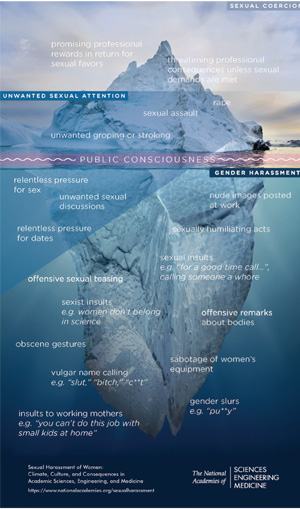September/October 2018
Communities: Education
The Iceberg of Sexual Harassment
The floodgates have opened. Almost every week it seems, a front-page news story details accusations of sexual harassment against another high-profile figure or in another industry. Within Silicon Valley, Hollywood, government, the arts, and more, women (and some men) are stepping forward to discuss incidents long kept hidden.
But a year before the #metoo movement grabbed the public consciousness, the National Academies of Sciences, Engineering, and Medicine had begun the task of examining sexual harassment within their fields of focus. In these fields—which are making concerted efforts to attract and retain more women—sexual harassment jeopardizes the efforts, the Academies stress. That includes driving women out of the professions or limiting their abilities to contribute and advance.
The work started in 2016, with a focus on academia. According to the consensus report, system-wide changes to higher education culture and climate are required to effectively respond to sexual harassment. There is no evidence that current policies and procedures, “which often focus on symbolic compliance with the law and on avoiding liability” have significantly reduced sexual harassment.
Holistic, evidence-based policies are necessary to reduce damage to research integrity and a costly loss of talent, according to the committee. Results of that talent drain could include economic and other consequences for the nation.
As the committee was finishing up its information gathering, the #metoo movement ignited. According to Frazier Benya, study director and program officer for the Academies’ Committee on Women in Science, Engineering, and Medicine, the larger conversation uncovered additional beneficial research and perspectives. It also increased the report’s potential impact. “More people were paying attention to the issue and willing to listen to what the committee said, and perhaps implement [recommendations].”
Among the most important outcomes, emphasizes both Benya and committee cochair Sheila Widnall, is the redefinition of sexual harassment to include gender harassment. As Widnall explains, it’s clear that sexual coercion and physical assault are sexual harassment and not allowed. But the definition needs to expand to examine the overall climate for female students. For example, do they feel comfortable? Are they teased? (See infographic.)
That’s probably the most important message the committee wants to provide universities, says Widnall, an MIT professor of aeronautics and astronautics. “In order for women to succeed and thrive in engineering, we want to see a welcoming climate.” How to do that can be summed up in one word, she emphasizes—leadership. “It’s the provost, deans, department heads, and faculty advisors.”
In their work, the committee members also made sure to examine issues of intersectionality, or where different factors, such as class, gender, race, and age, intertwine. According to Benya, research clearly shows that the experiences of sexual harassment can vary depending on these factors. It’s important not to generalize and say the research on white woman is true for populations with intersectional identities, she says, when sexual harassment can interact with other forms of discrimination or harassment, such as racial harassment. Therefore, she continues, “it may be a different experience and have different impacts.”
The report is finished after two years of work, but it’s only the first step. Committee members are continuing discussions on these issues, engaging with academic leaders and federal agencies. And they’re working at their own institutions to convey the results and discuss next steps.
As Widnall puts it, the committee has no plans to drop the issue. “We built a platform and established the nature of the issues that need to be taken seriously.”
Access Sexual Harassment of Women: Climate, Culture, and Consequences in Academic Sciences, Engineering, and Medicine and additional resources.
Go to the May 2017 PE feature on sexual harassment in engineering, “Crossing the Line.”


 Volunteering at NSPE is a great opportunity to grow your professional network and connect with other leaders in the field.
Volunteering at NSPE is a great opportunity to grow your professional network and connect with other leaders in the field. The National Society of Professional Engineers (NSPE) encourages you to explore the resources to cast your vote on election day:
The National Society of Professional Engineers (NSPE) encourages you to explore the resources to cast your vote on election day: ACCORDING TO THE NATIONAL ACADEMIES’ REPORT, THE DEFINITION OF SEXUAL HARASSMENT MUST EXTEND BEYOND SEXUAL COERCION AND UNWANTED SEXUAL ATTENTION TO INCLUDE THE MOST COMMON FORM, GENDER HARASSMENT.
ACCORDING TO THE NATIONAL ACADEMIES’ REPORT, THE DEFINITION OF SEXUAL HARASSMENT MUST EXTEND BEYOND SEXUAL COERCION AND UNWANTED SEXUAL ATTENTION TO INCLUDE THE MOST COMMON FORM, GENDER HARASSMENT.



